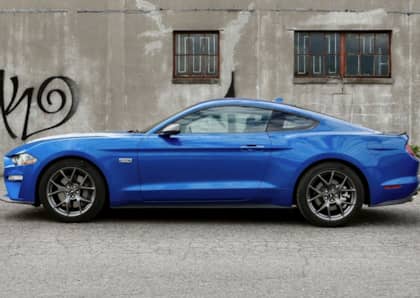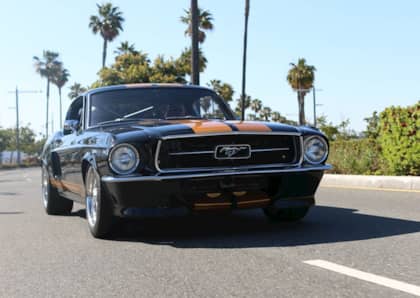A Brief History of the Ford Probe, the Mustang Replacement That Wasn't
The idea of replacing the Mustang seems misguided from our modern perspective. One of the longest-running nameplates in Ford history, this coupe/convertible combo has graduated from pony car to legitimate sports car, regularly challenging more exotic rides in terms of acceleration, grip and lap times.
There was a period in the 1980s, however, when the Blue Oval considered the Mustang to be more of an anachronism than a path forward. With its live-axle, rear-wheel drive setup and pushrod V8, the Mustang's tech quotient paled in comparison with the coupes streaming out of Chrysler, Toyota, Mitsubishi and even Chevrolet, as these vehicles brought dual-overhead cams, turbochargers, front or all-wheel drive and turbocharging to the fore.
The quest was on to substitute a more future-proof model in place of the 'Stang. While the end result, the Ford Probe, was certainly a viable competitor for entry-level performance dollars, the changing market and shifting focus at the Blue Oval brought an early end to the compact's run.
New Partners, New Horizons
Eager to leverage its new investment in Mazda, by 1983 Ford had decided that the next-generation Mustang would move in a radically different direction. Although still built in the United States, the Mustang would borrow a platform from the company's Japanese partner called the "G series," which featured a front-wheel drive layout and hosted a pair of four-cylinder engines—one of which would be turbocharged—as well as a tandem of V6 options.

Why such a drastic change? In addition to dealing with a sales slump for the current Mustang, Ford had been fearful of the chilling effect the energy crisis had had on the sales of inefficient V8 engines, which, when combined with power-choking pollution controls of the time, were beginning to feel like relics of a bygone era.
Windswept and bubble-like, with lots of glass and decidedly different proportions than what Ford performance fans were used to, the vehicle was on the cusp of production when disaster struck. Enraged by leaked details of the plan to de-muscle the Mustang, in 1987, thousands of irate owners sent letter after letter to Ford HQ urging the company to "rethink" the decision. This surprising outpouring of emotion, combined with a downward trend in fuel prices and a sudden surge in sales, bought a stay of execution to the Fox-platform Mustang.
An Intriguing Alternative
What, then, to do with the pony car's erstwhile replacement? Ford had come too far to simply dump the newcomer on the dust heap, but it needed a little more time to flesh out the details of an entirely new model that would eventually be sold alongside the Mustang.
By 1988, the plan was ready to be executed. Dubbed the Probe, a name borrowed from a past concept car, the coupe made a smashing debut at the Chicago Auto Show, which in turn lead to six-figure interest from dealers and potential buyers—momentum that carried the car through its first few years of production.

For its introductory 1989 model, the Probe was outfitted with a 110hp, 2.2L Mazda four-cylinder as its base engine, and it was possible to order a 145hp turbo version of the car (the Probe GT), which also delivered 190 lb-ft of torque. By 1990, a 3.0L V6 in the LX model provided 140hp and 140 lb-ft of twist, matched with a four-speed automatic (as opposed to the five-speed manuals offered with the sportier models). Reviews for the Probe lauded not just its attractive styling but also its excellent handling, thanks in part to an adjustable suspension system, and it compared favorably with the Mazda MX-6, which was for all intents and purposes its platform-twin.
A redesign of the Probe followed for 1993 models, and the lighter version of the car gained a more advanced DOHC 2.0L base engine that posted five horsepower over the departed mill. Even though the wider and somewhat longer Probe had a sportier look than before, it lost access to its turbocharged drivetrain, tagging in an advanced 164hp, 2.5L V6 engine (that traded in just over 30 lb-ft of the turbo's torque in the process).
Unfortunately for Probe fans, that was to be the last major effort from Ford at keeping the car competitive in a rapidly changing marketplace. As competitors continued to hone their sporty compact car options (witness the twin attack of the Honda Civic Si and the Acura Integra Type R throughout the '90s, as well as the ascendancy of the DSM Talon/Eclipse turbo AWD coupes) and the redesigned in-house Mustang claimed the lion's share of attention and promotion at home, the Probe lost its luster, falling far below its near 120,000 unit sales peak earlier in the decade to barely more than 15,000 sold by its final 1997 model year. This was despite the decision to expand the car's availability to both Europe and Asia (including Australia and New Zealand).
Ripple Effect
There is a strange and wistful postscript to the Ford Probe story. With its development dollars tied up in the development of the next-generation Mustang (the SN95, which would replace the original Fox in 1994), Ford decided that there simply wasn't enough space in the showroom for a pair of sporty two-doors. Still, eager to revitalize its sagging Mercury brand—and to give it a European flavor that it thought would entice a new demographic—it transferred the assets that had gone in to developing a replacement for the Probe to its sub-division, which eventually resulted in the birth of the front-wheel drive Cougar in 1999.

Although the Cougar wouldn’t enjoy the same longevity as the Probe, the latter's multifaceted journey from concept to production is a unique tale in the automotive pantheon. Ford's gamble on a front-wheel drive sports coupe might not have paid off as a direct replacement for the Mustang, but it certainly succeeded on its own merits, joining a raft of similar fun-to-drive options that dominated the streets in the late '80s and early '90s. It also served as an early forbearer of the smoother, more oval-intensive design language that would filter throughout the Ford family throughout the '90s.
Finally, it provided the kickstart that the Mustang needed to shake free from its 1970s roots and embrace a more modern chassis and engine update that would see the SN95 through the New Edge years all the way to the dramatic improvements that would mark the 2005-and-up editions of the car, paving the way for its current world-class performance car status.











